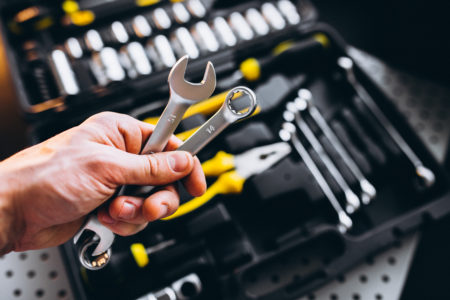
Hand Tool Safety
An old proverb in the building trades states that “A craftsman is only as good as his tools.”
Every competent tradesman, regardless of his field, must possess an extensive hand tool collection.
Hand tools in disrepair are a hazard to the person using them and to others nearby. A worker’s hand tools must be maintained in good repair to ensure safety for the user and to assure the quality of their work.
OSHA regulations state that “Employers shall not issue or permit the use of unsafe hand tools.”
Recommended Practices for General Hand Tool Safety:
General Tools:
- Always wear Personal Protective Equipment that is appropriate for the tool being used.
- Damaged, worn-out, or defective tools should be tagged and removed from service. Do not perform “make-shift” repairs to tools.
- Never use a tool if its handle has splinters, burrs, cracks, splits or if the head of the tool is loose.
- Do not use impact tools such as hammers, chisels, punches, or steel stakes that have mushroomed heads.
- When handing a tool to another person, direct sharp points and cutting edges down and away from yourself and the other person.
- Carry all sharp tools in a sheath or holster. Do not carry sharp or pointed hand tools such as screwdrivers, scribes, snips, scrapers, chisels, or files in your pocket unless the tool is sheathed. Transport hand tools only in toolboxes or tool belts.
- Use tied off containers to keep tools from falling off scaffolds and other elevated work platforms.
- Avoid carrying tools in your hand when you are climbing. Carry tools in tool belts or hoist the tools to the work area using a hand line.
- Do not throw tools from one location to another or from one employee to another.
Hammers:
- Do not use a hammer if your hands are oily, greasy, or wet.
- Never strike another hardened steel tool or surface, such as a cold chisel, with a claw hammer.
- Avoid striking nails or other objects with the “cheek” of the hammer.
- Do not strike one hammer against another hammer.
- Never use a hammer as a wedge or a pry bar.
Hand Saws:
- When using a hand saw, hold the work piece firmly against the worktable.
- Do not use an adjustable blade saw, such as a hack saw, or a coping saw if the blade is not taut.
- Avoid using any saw with a dull blade; always keep blades clean and sharp
- Keep hands and fingers away from the point of cut when using any saw.
- Never carry a hand saw by the blade.
Screwdrivers:
- Do not use a screwdriver if your hands are wet, oily or greasy.
- Always match the size and type of screwdriver blade to fit the head of the screw.
- Never hold the work-piece against your body while using a screwdriver.
- Avoid putting your fingers near the blade of the screwdriver when tightening a screw.
- Use a drill, nail, or an awl to make a starting or pilot hole for screws.
- Do not force a screwdriver by using a hammer or pliers on it.
- Never use a screwdriver as a punch, chisel, pry bar, or nail puller.
- When performing electrical work, ensure the screwdriver has a properly insulated handle.
Wrenches:
- Discard any wrench that has spread, nicked, or battered jaws, or if the handle is loose, broken or bent.
- Do not use a shim to make a wrench fit the fastener.
Pliers:
- Do not use pliers that are cracked, broken, or sprung.
- Never use pliers as a wrench or a hammer.
- Do not attempt to force pliers by using a hammer on them.
- When you are performing electrical work, use pliers that have properly insulated handles.
- When using diagonal cutting pliers, shield the loose pieces of cut material from flying into the air.
Having a good collection of the “Tools of the Trade” is important to any craftsman who intends to make a decent living in his chosen field. It is equally important that the hand tools be maintained and used in a manner that ensures safety to the one using the tools and others in the immediate work-zone. Follow these guidelines for safe hand tool practices.
Download a PDF of this Toolbox Talks in English
Download a PDF of this Toolbox Talks in Spanish

